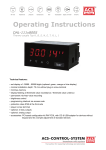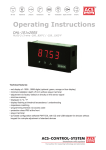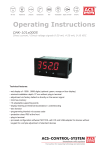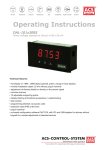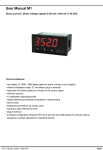Download Operating Instructions - ACS-CONTROL
Transcript
Operating Instructions User Manual M1 Pt100 2-/3-wire -200…850°C / -328…1562°F DAK-101x200S User Manual M1 Pt100 2-/3-wire: -200°C…850°C / -328°F…1562°F Pt100 2-/3-wire -200…850°C / -328…1562°F Technical features: • red display of -1999…9999 digits (optional: green, orange or blue display) • minimal installation depth: 27 mm without plug-in terminal • adjustment via factory default or directly on the sensor signal Technical features: • min/max-memory •• display flashing at threshold digits exceedance / undershooting red display of -1999…9999 (optional: green, orange or blue display) •• impedance matching minimal installation depth: 27 mm without plug-in terminal •• programming via access code on the sensor signal adjustment viainterlock factory default or directly •• protection class IP65 at the front min/max-memory •• plug-in display terminal flashing at threshold exceedance / undershooting •• pc-based configuration impedance matching software PM-TOOL with CD and USB-adapter for devices without keypad for a adjustment of standard devices • programmingsimple interlock via access code • protection class IP65 at the front • plug-in terminal • pc-based configuration software PM-TOOL with CD and USB-adapter for devices without keypad for a simple adjustment of standard devices Order code 2 6 power supply 24V DC galvanic seperated . . . . . . . . . . . . . . . . . . . . . . . . . . . . . . . . . . . . . . . . . . . . . . . . . . . . . 4-20mA 2-wire, current loop display . . . . . . . . . . . . . . . . . . . . . . . . . . . . . . . . . . . . . . . . . . . . . . function input 2 Pt100 input, 2 + 3-wire up to 850°C . . . . . . . . . . . . . . . . . . . . . . . . . . . . . . . . . . . . . . . . . . . function output 0 display . . . . . . . . . . . . . . . . . . . . . . . . . . . . . . . . . . . . . . . . . . . . . . . . . . . . . . . . . . . . DAK-101 2 2 0 9 standard configuration . . . . . . . . . . . . . . . . . . . . . . . . . . . . . . . . . . . . . . . . . . . . . dimension strips and configuration as specified . . . . . . . . . . . . . . . . . . . . . . . . . . . . S 0 standard, protection IP65 . . . . . . . . . . . . . . . . . . . . . . . . . . . . . . . . . . . . . . . . S ACS-CONTROL-SYSTEM GmbH l Lauterbachstr. 57 l D-84307 Eggenfelden l www.acs-controlsystem.de l [email protected] Content 1. Brief description 2 2. Assembly 2 3. Electrical connection and conenction examples 3 4. Function description and operation 4 4.1. Programming software PM-TOOL 4 Setting up the device 5 5.1. Switching on 5 5.2. Standard parameterisation (flat operation level) 5 5. Value assignment for control of the signal input, impedance matching 5.3. Programming interlock RUN 6 Activation/Deactivation of the programming interlock or change into extended parameterisation 5.4. Extended parameterisation 6 Superior device functions like e.g.: 6. - allocation of functions onto the navigation keys 7 - adjustment of limit values for optical alarm, LI-1/2 7 - safety parameter for locking of the programming, Code 7 Reset to default values 8 Reset of the parameter onto delivery condition 7. Alarms / Switching points 9 Functional principle of the optical switching points 8. Technical data 10 9. Safety advice 12 10. Error elimination 13 ACS-CONTROL-SYSTEM GmbH l Lauterbachstr. 57 l D-84307 Eggenfelden l www.acs-controlsystem.de l [email protected] 1 3 2. Assembly 1. Brief description 1. Kurzbeschreibung The panel instrument DAK-101 is a 4-digit device for Pt100 sensors and a visual limit value monitoringvia the display. The confi- The panel instrument M1-7C is a or 4-digit device forPC-software Pt100 sensors and aAnvisual limit programming value monitoring viaprevents guration happens via three front keys via the optional PM-TOOL. integrated interlock the display. changes The configuration happens front keys optional PC-software PM-TOOL. An unrequested of the parameter and via can three be unlocked againor viavia an the individual code. The electrical connection happens on prevents the rearside via plug-interminals. integrated programming interlock unrequested changes of the parameter and can be unlocked Selectable functions like e.g. the recall of the min/max-value,a zeropoint slowdown,a direct change of the limit value in operaagain via an individual code. ting mode an dadditional measuring points forvia linearisation complete the modern device concept . The electrical connection happenssupporting on the rear side plug-in terminals. Selectable functions like e.g. the recall of the min/max-value, an impedance matching up to 20°C and a direct change of the limit value in operating mode complete the modern device concept. 2. Assembly Please read the Safety advice on page 12 before installation and keep this user manual for future reference. 1. 2. 3. After removing the fixing elements, insert the device. Check the seal to make sure it fits securely. Click the fixing elements back into place and tighten the clamping screws by hand. Then use a screwdriver to tighten them another half a turn. CAUTION! The torque should not exceed 0.1 Nm! 4 2 ACS-CONTROL-SYSTEM GmbH l Lauterbachstr. 57 l D-84307 Eggenfelden l www.acs-controlsystem.de l [email protected] 3. Electrical connection 3. Electrical connection Type TypeDAK-101x200S M1-7TR4A.030C.770CD supply of 24 VDC Advice: The galvanic isolation in devices with temperature sensors, that do not have a galvanic connection to an extrinsic potential, can be cancelled by an bridge from terminal 3 to 4 and thus stabilise the device against external failures. ACS-CONTROL-SYSTEM GmbH l Lauterbachstr. 57 l D-84307 Eggenfelden l www.acs-controlsystem.de l [email protected] 5 4. Function description and operation 4. Function description and operation Operation The operation is divided into two different levels. Menu Level Here it is possible to navigate between the individual menu items. Parameterization level: The parameters stored in the menu item can be parameterized here. Functions that can be adjusted or changed are always indicated with a flashing of the display. Adjustments made at the parameterization level should be always confirmed by pressing the [P] key to save them. However, the display automatically saves all adjustments and then switches to operation mode if no further keys are pressed within 10 seconds. Level Button Description Change to parameterization level with the relevant parameters Menu level For navigation at the menu level To confirm the changes made at the parameterization level Parameterization level To change the value or setting Example: Menu level Parameterization level 4.1. Programming via configuration software PM-TOOL-MUSB12: You receive the software on CD including an USB-cable with a device adapter. The connection is done via a 12-pole micromatch connector plug on the back and the PC is connected via an USB connector plug. System requirements: Software: PC with USB interface Windows XP, Windows Vista With this tool the device configuration can be created, skipped and safed on the PC. Via the easy to handle program surface the parameter can be changed, whereat the mode of operation and the possible selection options can be preset via the program. CAUTION! During parameterisation with connected measuring signal, make sure that the measuring signal has no mass supply to the programming plug. The programming adapter is galvanic not isolated and directly connected with the PC. Via polarity of the input signal, a current can discharge via the adapter and destroy the device as well as other connected components! 4 6 ACS-CONTROL-SYSTEM GmbH l Lauterbachstr. 57 l D-84307 Eggenfelden l www.acs-controlsystem.de l [email protected] 5. Setting up the device 5. Setting up the device 5.1. Switching on Once the installation is complete, you can start the device by applying the current loop. Check beforehand once again that all the electrical connections are correct. Starting sequence For 1 second during the switching-on process, the segment test (8 8 8 8 8) is displayed, followed by an indication of the software type and, after that, also for 1 second, the software version. After the start-up sequence, the device switches to operation/display mode. 5.2. Standard parameterization: To be able to parameterize the display, press the [P] key in operating mode for 1 second. The display then changes to the menu level with the first menu item TYPE. Menu level Parameterization level Type of the temperature measurement, TYPE: Default: °C For representing of temperature choose between °C and °F and confirm with [P]. The display then switches back to the menu level again. Setting the decimal place / sign of physical unit, END: Default: 000.0 The decimal place and the physical unit are set with [▼] [▲]. If e.g. the temperature measurement is chosen in °C, 0°C or 0.0°C can be selected on the parameterization level. Confirm with [P], the display then switches back to the menu level again. Impedance matching, offs: Default: 0.0 The value for the sensor alignment is adjusted from the smallest to the highest place with [▼] [▲] and confirmed digit per digit with [P]. After the last place the display switches back to the menu level. The value alignment for a temperature measurement in °C can be set between -20.0 and +20.0 and for a measurement in °F between -36.0 and +36.0. If the measurement is redirected later, the value is rounded. Setting the display time, SEC: Default: 0i.0 then The display time is set with [▲] [▼]. The display moves up in increments of 0.1 sec up to 1 second and in increments of 1.0 to 10.0 seconds. Confirm the selection by pressing the [P] button. The display then switches back to the menu level again. 5 ACS-CONTROL-SYSTEM GmbH l Lauterbachstr. 57 l D-84307 Eggenfelden l www.acs-controlsystem.de l [email protected] 7 5. Setting up the device Menu level Parameterization level 5.3. Programming interlock RUN Activation / deactivation of the programming lock and completion of the standard parameterization, run: Default: uloc With the aid of the [▲] [▼] keys, you can choose between the deactivated key lock Uloc (works setting) and the activated key lock Loc. Make the selection with [P]. After this, the display confirms the settings with "- - - -", and automatically switches to operating mode. If Loc was selected, the keyboard is locked. To get back into the menu level, you must press [P] for 3 seconds in operating mode. You must now enter the CODE (works setting 1 2 3 4) that appears using the [▲] [▼] keys plus [P] to unlock the keyboard. FAIL appears if the input is wrong. 5.4. Extended parameterization By pressing the [▲] & [▼] buttons during standard parameterization for one second, the display switches to the extended parameterization mode. Operation is the same as in standard parameterization. Menu level Parameterization level Min/max-value inquiry - Assignment of key functions, Tast: Default: no Here, you can enter for the operating mode either a min/max-value inquiry or a threshold value correction on the arrow keys. If the min/max-memory is activated with EHER, the measured min/max-values will be saved during operation and can be called up via the arrow keys [▲] [▼]. The values are lost if the device is restarted. If the threshold value correction LI.1 is selected, the limit values can be changed during operation without hindering the operating procedure. With tara the display is tared to zero and is saved permanently as offset. The device confirms the correct taring by showing 0000 in the display. If No is parameterized, the navigation keys [▼] [▲] have no function in operating mode. Flashing of display, FLAS: Default: no Here, flashing of the display can be added as an extra alarm function, either to the first limit value (select: LI-1), the second limit value (select: LI-2) or to both limit values (select: LI-12). With No (works setting), no flashing is assigned at all. 8 ACS-CONTROL-SYSTEM GmbH l Lauterbachstr. 57 l D-84307 Eggenfelden l www.acs-controlsystem.de l [email protected] 6 5. Setting up the device Menu level Parameterization level Limit values / Limits, LI-1: Default: 0200 For both limit values, two different values can be parameterized. With this, the parameters for each limit value are called up one after the other. Hysteresis for limit values, HY-1: Default: 0000 For both limit values, a hysteresis function exists that reacts according to the functional principle (operating current / quiescent current). Function if display falls below / exceeds limit value, FU-1: Default: hi9h To indicate if the value falls below the lower limit value, Louu can be selected (LOW = lower limit value) and if it goes above the upper limit value, high can be selected (HIGH = upper limit value). LOW corresponds to the quiescent current principle and HIGH to the operating current principle. Limit value / Limits, LI-2: Default: 0300 For both limit values, two different values can be parameterized. With this, the parameters for each limit value are called up one after the other. Hysteresis for limit values, HY-2: Default: 0000 For both limit values, a hysteresis function exists that reacts according to the functional principle (operating current / quiescent current). ACS-CONTROL-SYSTEM GmbH l Lauterbachstr. 57 l D-84307 Eggenfelden l www.acs-controlsystem.de l [email protected] 7 9 6. Reset to default values Menu level Parameterization level Function if display falls below / exceeds limit value, FU-2: Default: hi9h To indicate if the value falls below the lower limit value, Louu can be selected (LOW = lower limit value) and if it goes above the upper limit value, high can be selected (HIGH = upper limit value). LOW corresponds to the quiescent current principle and HIGH to the operating current principle. Setting the code, CODE: Default: 1234 With this setting, it is possible to select an individual code (works setting 1 2 3 4) for locking the keyboard. To lock/release the key, proceed according to menu item run. 6. Reset to default values To return the unit to a defined basic state, a reset can be carried out to the default values. The following procedure should be used: • Switch off the power supply • Press button [P] • Switch on voltage supply and press [P]-button until „- - - -“ is shown in the display. With reset, the default values of the program table are loaded and used for subsequent operation. This puts the unit back to the state in which it was supplied. Caution! All application-related data are lost. 10 ACS-CONTROL-SYSTEM GmbH l Lauterbachstr. 57 l D-84307 Eggenfelden l www.acs-controlsystem.de l [email protected] 8 7. Functional principle of the switching points 7. Functional principle of the switching points Limit value exceedance “High” The switching point S1-S2 is “off” below the threshold and “on” on reaching the threshold. Limit value undercut “low” The switching point S1-S2 is “on” below the threshold and switched “off” on reaching the threshold. Alarms / optical switching point display An activated set point can be optically indicated by flashing of the 7-segment display. Functional principle of the alarms Alarm Deactivated, display value Threshold Threshold/limit value for switch over Hysteresis Width of the window between the thresholds Operating principle Limit value exceedance / limit value undercut ACS-CONTROL-SYSTEM GmbH l Lauterbachstr. 57 l D-84307 Eggenfelden l www.acs-controlsystem.de l [email protected] 9 11 8. Technical data 8. Technical data Housing Dimensions 48x24x27 mm (BxHxD) 48x24x54 mm (BxHxD) including plug-in terminal Panel cut-out 45.0+0.6 x 22.2+0.3 mm Insulation thickness up to 3 mm Fixing snap-in screw element Material PC Polycarbonate, black, UL94V-0 Sealing material EPDM, 65 Shore, black Protection class standard IP65 (front), IP00 (back side) Weight approx. 100 g Connection plug-in terminal; wire cross section up to 2.5 mm 2 Display Digit height 10 mm Segment colour red (optional green, orange or blue) Display range -1999 to 9999 Setpoints optical display flashing Overflow horizontal bars at the top Underflow horizontal bars at the bottom Display time 0.1 to 10.0 seconds Input Measuring range Measuring fault Digit Pt100 2-/3-wire -200…850°C 0.1 % of measuring range ±1 Pt100 2-/3-wire -328…1562°F 0.1 % of measuring range ±1 Accuracy 12 Temperature drift 100 ppm / K Measuring time 0.1…10.0 seconds Measuring principle U/F-conversion Resolution 0.1°C or 0.1°F Power pack 24 VDC ±10 % max. 1 VA Memory EEPROM Data life ≥ 100 years at 25°C 10 ACS-CONTROL-SYSTEM GmbH l Lauterbachstr. 57 l D-84307 Eggenfelden l www.acs-controlsystem.de l [email protected] 8. Technical data Ambient conditions Working temperature 0°C…60°C Storing temperature -20°C…80°C Weathering resistance relative humidity 0-80% on years average without dew EMV EN 61326 CE-sign Conformity to directive 2004/108/EG Safety standard According to low voltage directive 2006/95/EG EN 61010; EN 60664-1 ACS-CONTROL-SYSTEM GmbH l Lauterbachstr. 57 l D-84307 Eggenfelden l www.acs-controlsystem.de l [email protected] 11 13 9. Safety advices 9. Safety advices 9. Safety advice 9. Safety advice Please read the following safety advice and the assembly chapter 2 before installation and keep it Please read the following safety advice and the assembly chapter 2 before installation and keep it for future reference. for future reference. Proper use Proper use The is designed evaluation and display of Pt100 signals. The DAK-101--device M1-7C-device is designed forfor thethe evaluation and display of Pt100 signals. The M1-7C-device is designed for the evaluation and display of Pt100 signals. Danger! Careless use or improper operation can result in Danger! Careless orand/or improper operation result in personal use injury damage to thecan equipment. personal injury and/or damage to the equipment. Control of the device Control of the device The panel meters are checked before dispatch and sent out in perfect condition. Should there be The panel meters arewe checked beforeclose dispatch and sentofout perfect condition. there be any visible damage, recommend examination theinpackaging. Please Should inform the any visible damage, we recommend close examination of the packaging. Please inform the supplier immediately of any damage. supplier immediately of any damage. Installation Installation The M1-7C-device must be installed by a suitably qualified specialist (e.g. with a qualification in The DAK-101-device must installed a suitably qualifiedspecialist specialist (e.g. (e.g.with withaaqualification qualificationin in The M1-7C-device must bebe installed byby a suitably qualified industrial electronics). industrial industrial electronics). electronics). Notes on installation Notes on installation • There must be no magnetic or electric fields in the vicinity of the device, e.g. due to • There must be no phones magnetic or electric fields in the vicinity of the device, e.g. due to transformers, mobile discharge. or electrostatic transformers, mobile phones or electrostatic discharge. • The fuse rating of the supply voltage should not exceed a value of 6A N.B. fuse. • The fuse rating of the supply voltage should not exceed a value of 6A N.B. fuse. • Do not install inductive consumers (relays, solenoid valves etc.) near the device and • Do not install (relays, valves etc.) combinations near the device and suppress any inductive interferenceconsumers with the aid of RCsolenoid spark extinguishing or freesuppress any interference with the aid of RC spark extinguishing combinations or freewheeling diodes. wheeling diodes. • Keep input, output and supply lines separate from each other and do not lay them parallel with • Keep input, output and supply separate fromtoeach and Where do not lay them parallel with each other. Position “go” and lines “return lines” next oneother another. possible use twisted each other. Position “go” and “return lines” next to one another. Where possible use twisted pair. So, the best measuring results can be received. pair. So, the best measuring results can be received. • Screen off and twist sensor lines. Do not lay current-carrying lines in the vicinity. Connect the • Screen off and twistside sensor Do potential not lay current-carrying linessignal in theground). vicinity. Connect the screening on one on alines. suitable equaliser (normally screening on one side on a suitable potential equaliser (normally signal ground). • The device is not suitable for installation in areas where there is a risk of explosion. • The device is not suitable for installation in areas where there is a risk of explosion. • Any electrical connection deviating from the connection diagram can endanger human life • Any electrical connection deviating from the connection diagram can endanger human life and/or can destroy the equipment. and/or can destroy the equipment. • The terminal area of the devices is part of the service. Here electrostatic discharge needs to be • avoided. The terminal area ofHigh the voltages devices iscan part of thedangerous service. Here Attention! cause bodyelectrostatic currents. discharge needs to be avoided. Attention! High voltages can cause dangerous body currents. • Galvanic isolated potentials within one complex need to be placed on an appropriate point • (normally Galvanic isolated one So, complex need to be placed on an against appropriate point earth orpotentials machineswithin ground). a lower disturbance sensibility impacted (normally earth or machines ground). So, a lower disturbance sensibility against impacted energy can be reached and dangerous potentials, that can occur on long lines or due to faulty energy can can be beavoided. reached and dangerous potentials, that can occur on long lines or due to faulty wiring, wiring, can be avoided. 14 12 12 ACS-CONTROL-SYSTEM GmbH l Lauterbachstr. 57 l D-84307 Eggenfelden l www.acs-controlsystem.de l [email protected] 10. Error elimination 10. Error elimination Error description Measures 1. The unit permanently indicates overflow. • The input has a very high measurement, check the measuring circuit. • The input is open. 2. The unit permanently shows underflow. • The input has a very low measurement, check the measuring circuit . • The input is open. 3. The word "HELP " lights up in the 7-segment display. • The unit has found an error in the configuration memory. Perform a reset on the default values and re-configure the unit according to your application. 4. Program numbers for parameterising of the input are not accessible. • Programming lock is activated • Enter correct code 5. "Err1" lights up in the 7-segment display • Please contact the manufacturer if errors of this kind occur. 6. The device does not react as expected. • If you are not sure if the device has been parameterised before, then follow the steps as written in chapter 6 and set it back to its delivery status. 7. The temperature value is unstable. • Please check the possibility to set aside the galvanic insulation for a discharging of failures as described under chapter 3 „Electrical connection“. Before make sure that the possible metal sensor is separated from the sensor element. ACS-CONTROL-SYSTEM GmbH l Lauterbachstr. 57 l D-84307 Eggenfelden l www.acs-controlsystem.de l [email protected] 15 Pegel Druck Temperatur Durchfluss Registrierung Visualisierung ¸ Füllstand Messumformer Sensorik USV Wir erwarten Ihren Anruf. ACS-CONTROL-SYSTEM GmbH Lauterbachstr. 57 D- 84307 Eggenfelden know how mit System Ihr Partner für Messtechnik und Automation ¸ [email protected] www.acs-controlsystem.de Stand 07/2014 ACS-CONTROL-SYSTEM Tel: +49 (0) 8721-9668-0 Fax: +49 (0) 8721-9668-30

















